#berlin wool work embroidery
Text

An embroidery meme
@subarux99
#hand embroidery#crewel embroidery#berlin wool work embroidery#stumpwork#blackwork#sashiko#cross stitch
23 notes
·
View notes
Note
Can you run through the basics of 1870s men's fashion (circa 1875)? I know nothing about men's fashion and I need my character to be Plausible™
A great resource for a quick overview of 19th century fashion is the State University of New York Fashion Institute of Technology and their decade-by-decade fashion timelines: here's 1870-1879. It's legitimate and scholarly with sources cited so you can follow up on any claims and learn more about anything of interest!
I love Handbook of English Costume in the 19th Century by pioneering dress historians Phillis Cunnington and C. Willett Cunnington, which is also on Internet Archive (free account needed to access it). The FIT timeline notes that 1870s menswear is "marked by sobriety and understated style," and the Cunningtons add some additional context that the collapse of the French Empire after the Franco-Prussian War "produced a revulsion in France of anything savouring of 'Empire' style" which contributed to overall more subdued men's fashion.
Some other men's 1870s details from Handbook of English Costume in the 19th Century: trousers are all fly front and without a waistband, evening dress is generally black, and the "general absence of thin materials and light-weight cashmeres was characteristic of this warmly-clad buttoned-up decade." Dressing gowns with "fancy patterns and girdles of Berlin wool-work [a type of embroidery]". Men's jewellery less conspicuous and consisting only of "the heavy gold watch-chain across the waistcoat, the tie pin, and the signet-ring on the finger."
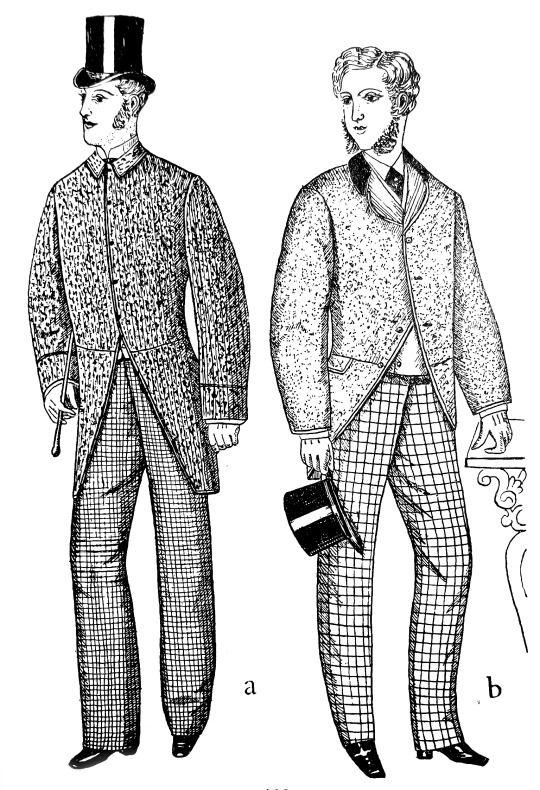
The difference between A, 1878 morning coat with Prussian collar, and B, an 1870 morning coat, shows the closer fit over the course of the decade. B looks very 1860s.
I think it's important to keep in mind that even the more somber, subdued menswear of the 1870s (especially compared to the 1820s-1840s) is still not as dark and boring as modern menswear.
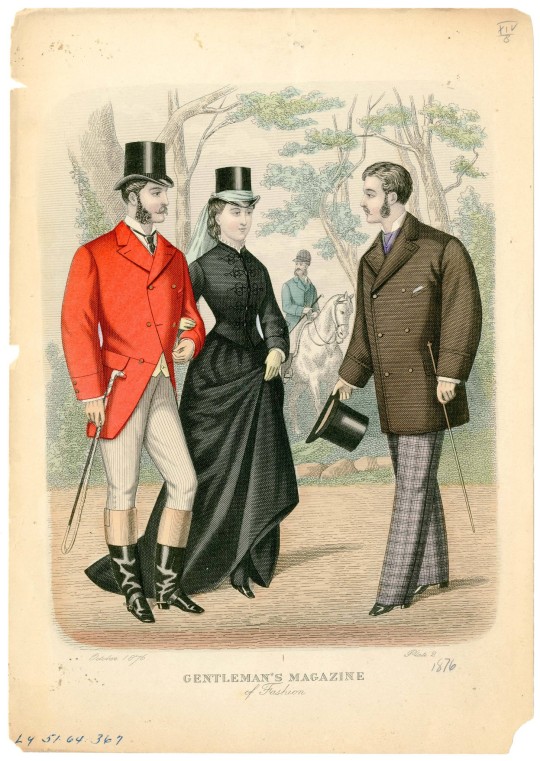
Here's a fashion plate dated 1876 in the Met Collection. The gentleman at left is in riding dress with spurred topboots that wouldn't look out of place in 1830. Which brings me to another important point: throughout the 19th century, (middle class and upper class) men have Special Outfits for different occasions and activities. A man circa 1875 would want to have different outfits for participating in various sports, hunting, evening parties, daytime business wear, etc.
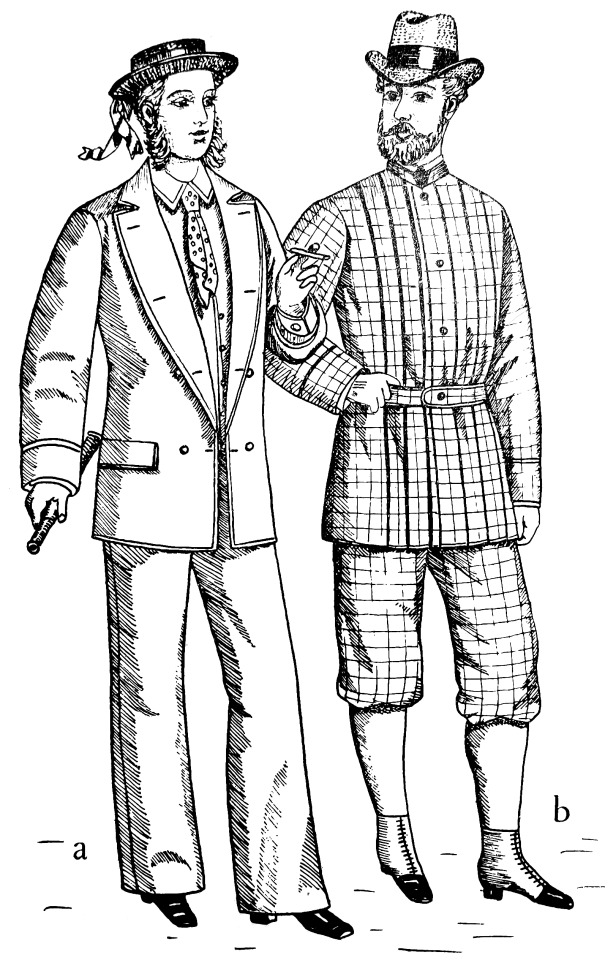
Two outdoorsy looks of 1876: yachting costume (A), and Norfolk jacket (B) "suitable for any kind of outdoor exercise."
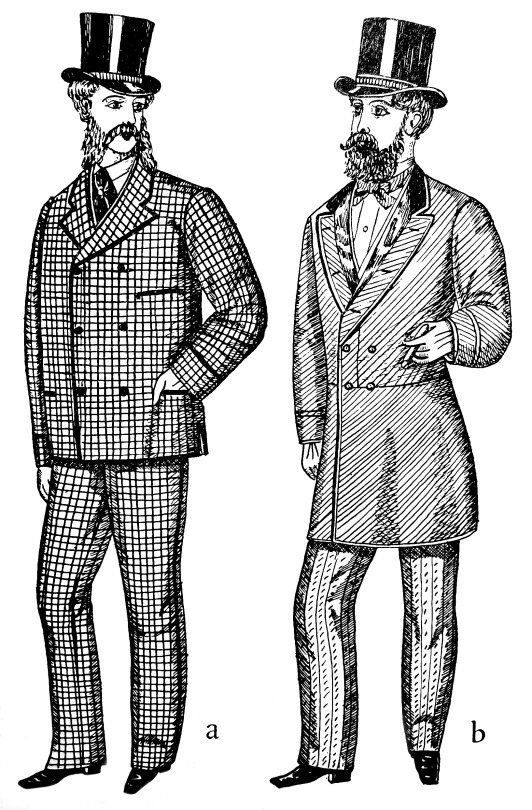
A is a "business suit for all occasions" from 1873, and B is a frock coat of 1874.
Facial hair facial hair facial hair in all these looks, and men are still wearing plaids/checks! (Plaid: perhaps the most characteristic trait of all 19th century men's clothing). The Cunningtons quote the West End Gazette of Fashion from 1876 that "Our fast young men will find something to be noisy in, in the shape of loud plaids, the patterns more striking than tasteful."
#1870s#fashion plates#dress history#fashion#victorian#historical men's fashion#men's fashion#fashion history#not putting a readmore 1870s be upon ye#looking up contemporary photography from cartes des visites could also be helpful#asks
40 notes
·
View notes
Text
Significance of Hand Embroidery And Crochet Work – A Dying Work of Art!
Primitive humankind quickly found that the stitches used to join animal skins together could also be used for embellishment. These creative minds then started the use of embroidery to enliven their existence. Hand embroidery is one of the oldest forms of art and craft, with origins dating back to the Cro - Magnon days or 30,000 BC. Recorded history, sculptures, paintings and vases depicting inhabitants of various ancient civilizations show people wearing thread - embroidered clothing. During a recent archaeological find, fossilized remains of heavily hand - stitched and decorated clothing, boots and a hat were found. Furthermore, Chinese thread embroidery dates back to 3500 BC, and examples of surviving Chinese chain stitch embroidery worked in silk thread have also been found and dated to the Warring States period ( 5th – 3rd century BC). Embroidery and most other fiber and needlework arts are believed to originate in the Orient and Middle East.
During 1100 A.D., smaller seed pearls were sewn on vellum to decorate religious items and from the 1200's through 1300's beads were embroidered onto clothing. By 1500 A.D., embroideries had become more lavish in Europe, as well as other areas of the world. From this period through the 1700's elaborate thread and bead embroidery gained popularity. Bead embroidery could be found on layette baskets, court dress, home furnishings and many other items.
Elaborately embroidered napkins clothing, religious objects, and household items have been a mark of wealth and status in many cultures including ancient Persia, India, China, Japan, Byzantium, and medieval and Baroque Europe. Traditional folk techniques were passed from generation to generation in cultures as diverse as northern Vietnam, Mexico, and Eastern Europe. Professional workshops and guilds arose in medieval England. The output of these workshops, called Opus Anglicanum or "English work," was famous throughout Europe.
In the latter half of the 19th century, however, the manufacture of machine - made embroideries in St. Gallen in eastern Switzerland started to flourish. The process used to tailor, patch, mend and reinforce cloth later fostered the development of sewing techniques, and the decorative possibilities of sewing led to the art of embroidery. Sadly, elaborate freehand stitched thread embroidery began to dwindle with the machine age of the 1800's when Art needlework and Berlin wool - work appeared on the scene.
Nonetheless, handcrafted embroidery and crochet work hold a special place in the art world, both for their historical and functional uses. From intricate stitches and colorful yarns, handmade items can be transformed into pieces of art that tell a meaningful story or bring joy to the wearer or user.
These works of art are also highly functional, and are often used to decorate fabrics, create warm garments, or bring a unique personal touch to a home. Items such as curtains, bedspreads, and tapestries can be crafted with intricate stitches and patterns. Whether it is a modern traditional cushion cover, or a napkin with intricate hand – embroidery, these handmade items can also be used to make personal and emotional connections. Through a shared story, skill, or culture, handmade embroidery and crochet work can create a strong bond between the maker and the recipient.
The significance of these products goes far beyond their aesthetic appeal. Crafting items with one’s own hands is an art form: one that requires skill, patience, and dedication. It is a practice that has been passed down from generation to generation and is a source of both pride and joy. Handcrafted items can also be a form of self - expression and a way to capture memories, making them more valuable and meaningful than the dull store - bought items.
In this day and age, handmade embroidery and crochet work have more significance than ever. As the world turns to technology for more and more of the daily needs, the act of crafting something by hand has become increasingly rare. By supporting independent makers and artisans, we can help ensure that the tradition of handmade crafts will live on for generations to come. For more information, please visit: https://naxos-art.gr/
1 note
·
View note
Text
Sailors Needlework
Due to the fact that sailors had to mend their own clothes and there was always a sailmaker with his mates, many on board were very talented sewers. Therefore, many of them went beyond simple mending and created their own clothes. Or began to embellish their pieces with embroidery or make presents for their loved ones. Or earning some money on the side with their skills.

Sailor doing needlework, c. 1850 by unknown in: Jack Tar a Sailors Life, by J. Welles Henderson
It is not possible to pinpoint the exact origins, as many pieces have been lost over time.

A knitted wool hat and handsewn pants, from HMS Invincible, 1758, in: The First HMS Invincible (1747-58): Her Excavations (1980-1991), by John M Bingeman
Some pieces date from the 18th century, while most seem to date from the 19th or 20th century. However, it can be assumed that there are also much older examples.
Embroideries
This type of decoration was embroidered with coloured silk or wool threads on the shirts or duffle bags. But also ribbons, bags or money belts were decorated.
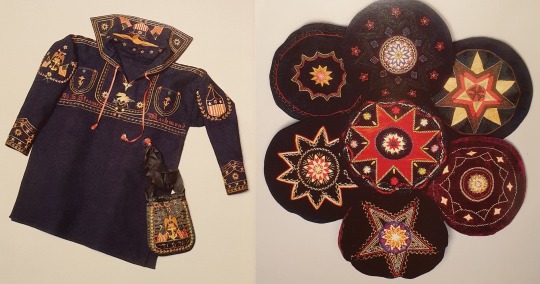
Sailor blouse and poke bag, made by George W.W. Dove, c. 1860 - Sailor’s Hats, c. 1850-1900 in: Jack Tar a Sailors Life, by J. Welles Henderson
Then names, mottos, stars, figures, ships, flags or anchors were embroidered on them.

Money belt, c. 1850 in: Jack Tar a Sailors Life, by J. Welles Henderson
Often the work was done in simple chain-stitch and the material was either taken from home or bought in a harbour.
Wollies
This type of embroidery is a very special form of embroidery, the embroidered woolen pictures, called woolies, which have been around since the 1840s. Most of the materials used to make woolies were found on board ships. Sailcloth, duck cloth from sailor's trousers or a simple linen or cotton fabric served as the backing. The runner was usually made from surplus wood with simple mortise and tenon joints, without wedges.

Theatrical curtains, often depicting trade union banners, suggest the artist was a merchant sailor. c. 1875 - HMS Trafalgar, c. 1865 (x)
Only the Berlin wool, cotton or silk had to be brought from home or purchased in a foreign port. The sailors mainly chose vivid colours - especially white, blue, red, brown and various shades of green. Early Woolies are made from naturally dyed wool. After the development of chemical dyes in the mid-1850s, sailors could obtain a wider range of colours at a cheaper price.

HMS Cumberland, c. 1842 - A third rate together with a paddle steamer, c. 1860-1880 (x)
When making a woolie, the sailor sometimes first sketched the outline of the ship and rigging in ink. With only these schematic designs, he then sewed these images freehand directly onto the canvas, using both rudimentary and refined stitches. Indeed, many Woolies show charming liberties taken with the appearance of elements other than the ship.

Multiple ships raise the value of a piece. This one showcases a second-rate ship, fourth-rate ship, frigate, and smaller ship, 1875 - HMS Queen a present from my son, c. 1855 (x) in: Jack Tar a Sailors Life,by J. Welles Henderson
The sailors used a wide variety of stitches, such as cross stitch, chain stitch, darning and the quilting technique called trapunto. Many of these pictures were appropriately made for the dearest ones at home. As the Victorians liked to collect, the pictures quickly became very popular and were often sold.
Knitting
The men on board also did this. Even though it's hard to imagine how old salts sat there and knitted. But for the cold days, the men needed warm clothes and so they knit socks, gloves and scarves.
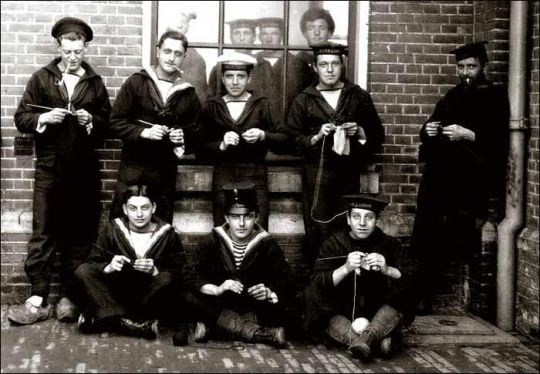
British sailors knitting or crocheting (and looking like they enjoy it!) during WWI (x)
(Those who have read the Hornblower novels by CS Forester will perhaps remember that in some books it is mentioned that the men sat there and knitted.) It is verifiable that the Sailors knitted from the 18th century onwards, but since this art had also been known since the 13th century, it must have come on board earlier.
4K notes
·
View notes
Photo
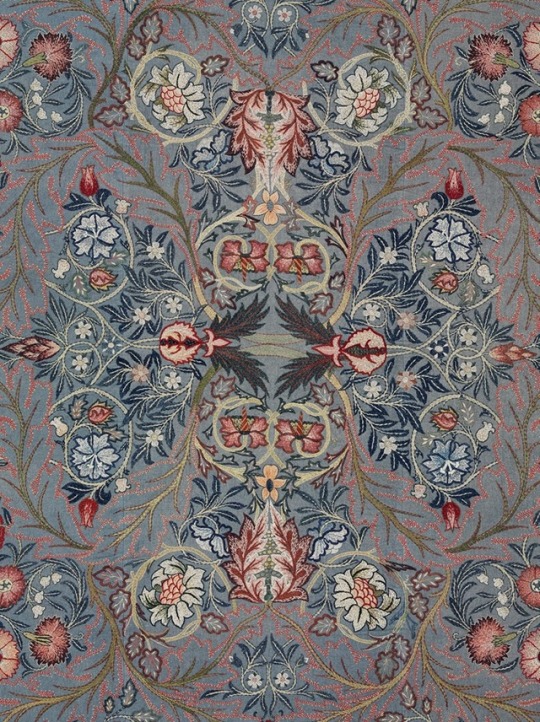
Acanthus (Wall Hanging), ca. 1880
felted woolen cloth, embroidered with silks
May Morris was an influential embroideress and designer, although her contributions are often overshadowed by those of her father, a towering figure in the Arts and Crafts movement. Morris himself is credited with the resurrection of free-form embroidery in the style which would be termed art needlework. Art needlework emphasized freehand stitching and delicate shading in silk thread, and was thought to encourage self-expression in the needleworker; this contrasted sharply with the brightly coloured Berlin wool work needlepoint and its "paint by numbers" aesthetic which had gripped much of home embroidery in the mid-nineteenth century.
May Morris was active in the Royal School of Art Needlework (now Royal School of Needlework), founded as a charity in 1872 under the patronage of Princess Helena to maintain and develop the art of needlework through structured apprenticeships.
20 notes
·
View notes
Photo
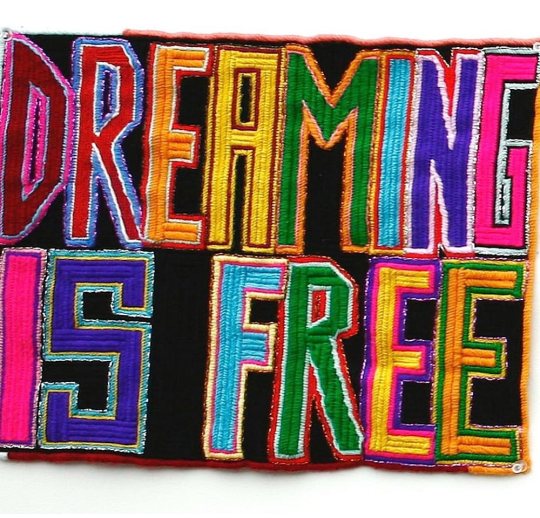
@michaelreidberlin We are pleased to present an ONLINE exhibition of works by Leah Emery & Paul Yore alongside their inclusion in "SOFT_WARE" @kunsthauserfurt this September. As Australian, New York-based, Art Consultant, @vasilikaliman recently wrote on @paul.yore's work: “Having lived as an Australian in New York for the past five years, what’s become clear is you can’t wait for the world to come to you as an artist. Australian artists haven’t had the luxury of enjoying the same level of global recognition as their peers overseas, but are as good as anywhere else around the world. Even though globalisation has made us reevaluate the provincialism problem in the Australian art world via an internet connection and Instagram account, nothing comes close to experiencing artworks in the optimum conditions of exhibition spaces.” SOFT_WARE is curated by David Ashley Kerr and Sarah Crowe and on view 04.09.2020 – 23.10.2020. Image: Paul Yore DREAMING IS FREE, 2016 wool needlepoint 34 × 43 cm #paulyore #leahemery @leahemeryart #kunsthauserfurt #software #crossstitch#embroidery #embroideryart #crossstitchart #leahemeryart #australianart #australianartist #art #needlecraft #needlework #textiles #tapestry #queer #activism #stitching #craftivism #contemporaryart #vasilikaliman #michaelreidberlin #michaelreidonline (at Michael Reid Berlin) https://www.instagram.com/p/CErxSMHqSLm/?igshid=1pnk7wuwufyrm
#paulyore#leahemery#kunsthauserfurt#software#crossstitch#embroidery#embroideryart#crossstitchart#leahemeryart#australianart#australianartist#art#needlecraft#needlework#textiles#tapestry#queer#activism#stitching#craftivism#contemporaryart#vasilikaliman#michaelreidberlin#michaelreidonline
0 notes
Text
Valentino
Valentino
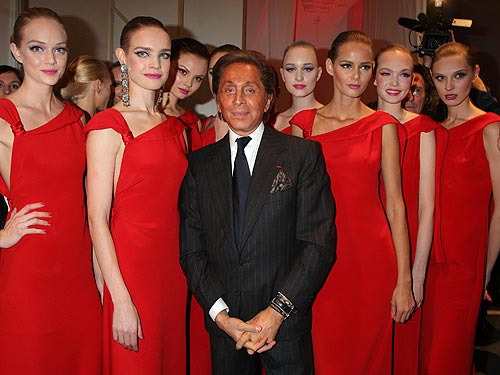
In post-World War 2, largely thanks to Christian Dior, Paris regained its position centre of international couture. Twice a year couture – foreign people are not welcome although they could enter as workers. Italy was beginning to develop a reputation for bright, attractive sport clothes. Such as calf-length trousers= Capri pants, cashmere.
Valentine Clemente Ludovico Garavani was born on 11 May 1932 in Voghera, a small town about midway between Turin and Millan. He took a keen interest in fashion, painting, architecture. Following this, he took a Berlin course in French and then moved to Paris. A young man of many interests and passion, he also took dance lessons and developed a love of French theatre.
He won a competition for fashion design run by the international Wool Secretariat – Yves Saint Laurent and Karl Lagerfeld were to be winners a few years later.
During this period, he was learning his craft, he paid a visit to the opera in Barcelona and was stuck by the fact that all the costumes onstage were red. Then as he recalled “that after black and white there was no finer colour” so he favoured red above all other colours at Desses. It would be associated with his name as shocking pink.

In 1957, Valentino went with Guy Laroche, who decided to open his own salon. Two years later he decided to set up his own fashion house with financial help from his father. He presented his first collection of 120 styles in Rome. The first to be impressed by the young designer was the movie star Elizabeth Taylor, in Rome. She ordered a white dress to wear for the world premiere pf Spartacus. Numerous film stars, from Audrey Hepburn and Rita Hayworth to Italians like Monica Vitti, Sophia Loren, Ornella Muti and Claudia Cardinale to Hollywood’s Jessica Lange and current luminary, Sharon Stone were to follow.
Early in the 1960s, swinging Loudon caught the world’s attention and inexpensive London fashions overshadowed couture. Valentino was ready to meet the challenge. Within a year, he had introduced his first ready-to-wear collection.
In the same year, 1960, Giancarlo Giamatti, an architecture student, joined the fashion house so Valentino was able to spend more time on the actual designing.
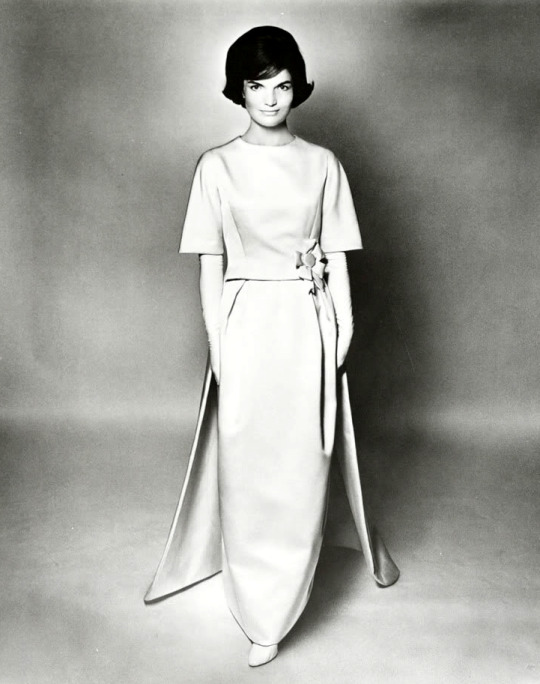
In 1962 Aleida Valli was chosen as the most elegant women at a Venice festival. Two years later Jacqueline Kennedy started you wear his clothes and in 1968 she would choose valentine as designer of the dress for her wedding with Aristotle Onassis. She remained a friend of Valentino, wearing his clothes throughout her life. In the years Marisa Berenson and Elsa Petretti were to be his fetish models.

Jacqueline Kennedy is his favourite lifetime model
1960s, Valentino produced many styles that reverberate in the history of fashion. It was a turbulent decade, representing the growth of a counterculture that saw elegant clothes was as an irrelevance. But Valentino consistently incorporated details from the world’ s cultural heritage, from the ancient Egyptian and classic Roman cultures to the painting of Klimt and Schiele. Echoes of art Nouveau and Pop Art also gave breath to his collections.
His continued use of black combined with white was widely popular and his animal prints, included leopard, zebra and giraffe marking were timeless in their appeal.
Valentino’s work became increasingly mature during the 1980s, mixing elegant craftsmanship, luxurious but often delicate embroideries and complex pleating. Details carried echoes of diverse cultures, drawing on medieval statuary, eightieth-century Chinese ceremonial screens, Japanese lacquered boxes and art Deco architecture.
Motifs favoured by Valentino from the beginning of his career.
Pleats were both used both horizontally and vertically to create patterns of their own.
Animal patterns were achieved using fabrics alone, like the alternating black -and-white panels of pleated chiffon that slithered around the body to suggest a zebra’s stripe.
Flesh-coloured chiffon is embroidered in gold, copper and brown sequins to resemble a leopard’s spots, while in a long narrow dress under a black lace obvers-skirt the addition of black sequins gives the effect of a cobra’s skin.
Not everything is severely classic. The double coat, e.g is a practical idea: two coats in matching or contrasting coloured which can be buttoned together to form a single warm coat or separated to make two lighter garments.
Black is the foundation for elegance in dress, is varied by Valentino’s constant preoccupation with red.
Red – whether chiffon, organza, satin or crepe – has been a leitmotif throughout Valentino’s career. It is popular with stars and fashionable women who want to be noticed.
Red – the color of life, blood and death, passion and love, the ultimate cure for sadness.
Morris, B. (1996). Valentino. London: Thames and Hudson.
Personal Life
Valentino and Giammetti maintain homes around the world, including villas in Spain, France and Switzerland. These homes are filled with art, which they avidly collect. Valentino has a penchant for dogs, particularly pugs—of which he owns many.
Later Career and Retirement
In 1998, Valentino and Giammetti sold their company for approximately $300 million to the Italian conglomerate HdP. In 2002, HdP sold the Valentino brand to Marzotto Apparel. Valentino remained actively involved with the company throughout these changes in ownership.
In 2007, Valentino announced that he would hold his final haute couture show in January of the following year. This final show, presented at the Musée Rodin in Paris, featured legendary models including Naomi Campbell, Claudia Schiffer and Eva Herzigova, who had worked with Valentino throughout their runway careers.
Posted on
May 3, 2019
Leave a commenton Valentino
Edit
The Journey Begins
Thanks for joining me!
Good company in a journey makes the way seem shorter. — Izaak Walton
0 notes
Photo

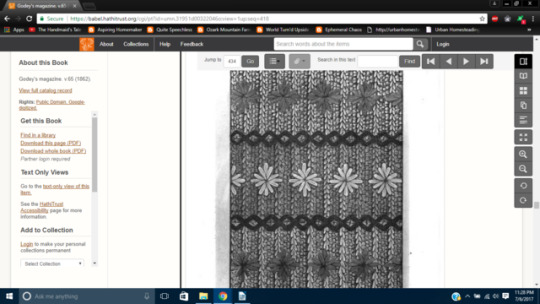
Top image: “Carriage Wrapper.” Source: Peterson’s Magazine, vol. 41 and 42, Jan. to Dec. 1862, page 334 and 391 in second half.
Bottom image: “Carriage Wrapper.” Source: Godey’s Lady’s Book, vol. 65, June to Dec. 1862, page 418 and 475.
Peterson’s text: IN the front of the number we give an engraving of a beautiful and new pattern for a Carriage Wrapper. It is worked in single crochet, in different colored stripes, in Berlin wool. When each stripe is sufficiently long, the stars are worked in with a wool needle, each of the four leaves requiring three stitches to for, it. This part of the work is very slight, but it adds much to the appearance of the work. All the stitches of each star meet in the center, but the middle stitch in each leaf is longer at the top. When the stripes are completed they are joined together by a double row of sewing, the stitches being taken all one way, and the contrary way returning, so that they cross each other; for this purpose black wool must be used. The arrangement of the colors are in some measure fixed by the laws of contrast: maize-color, violet, green, gray, and Magenta join well together, without being too violent in effect. The stars should be in alternate rows of black and white. A fringe, composed of the different colors, with black interspersed, completes this wrapper.
Godey’s text: (See engraving, page 434.) FOR the open carriage an ornamental wrapper is an elegance as well as a convenience. These should be light, and yet warm, and in a material that cannot be injured by crumpling; they should also be in a variety of well-contrasted colors, this adding very much to the advantageous effect of dress and style. The one we are now giving forms a very agreeable occupation while in progress, and a very handsome and useful article when completed. It is worked in single crochet, in different-colored stripes, in Berlin wool. When each stripe is sufficiently long, the stars are worked in with a wool needle, each of the four leaves requiring three stitches to form it. This part of the work is very slight, but it adds much to the appearance of the work. All the stitches of each star meet in the centre, but the middle stitch in each leaf is longer at the top. When the stripes are completed they are joined together by a double row of sewing, the stitches being taken all one way, and the contrary way returning, so that they cross each other; for this purpose black wool must be used. The arrangement of the colors is in some measure fixed by the laws of contrast; maize-color, violet, green, gray, and Magenta join well together, without being too violent in effect. The stars should be in alternate rows of black and white. A fringe, composed of the different colors, with black interspersed, completes this wrapper.
Modern directions: The stripes are running horizontally across the images above. Each stripe appears to be a few inches wide. Squinting and counting, I see at least 15 stitches per stripe. Working single crochet through both loops will give you a solid, flat surface for working embroidery. The black Xs going across the work almost look purely ornamental. It may be a good idea to crochet the strips together using one of the strip colors, and then work the black Xs just for show.
#picture#text#crochet#19th century#1860s#1862#double feature#godey's#peterson's#godey's 1862#peterson's 1862#original posts#transcribed pattern#victorian afghans#edit later
0 notes
Text


Men's embroidered slippers, second half of the 19th century. An example of the style known as Berlin wool work, they are embroidered in wool thread on a canvas ground. (The John Bright Collection).
#victorian#embroidery#men's fashion#fashion history#historical men's fashion#berlin wool work#dress history#slippers#extant#victorian fashion#i assume the pair with naval ensigns is pre-1864 it still has the three colour squadron flags#woolwork
30 notes
·
View notes
Text
Varieties of Embroidery Style given by universal tailors Bangkok
The craft of hand embroidery is experienced everywhere the planet and involves a colossal range of techniques, stitches, threads, base materials and elaborations. There's no universal manner of classifying embroidery, as totally cultures use different terms to explain stitches and techniques. This guide introduces a number of the foremost common embroidery designs found in our collections, divided into three main types: counted-thread, race and white work. Also, universal tailors Bangkok offer all type embroidery clothes that are very reasonable and affordable for all.
Top tailors in Bangkok use top quality threads for making embroidery designs on clothes. Top 5 tailors in Bangkok make all clothes according to customer requirements.
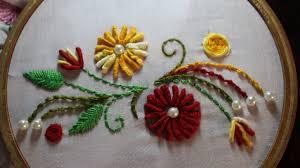
Counted-thread
Counted-thread (or merely 'counted') embroidery describes all forms created employing a planned variety of stitches – over a particular variety of threads or sections within the foundation cloth. These usually feature regular (and typically repeated) patterns created employing a combination of some comparatively easy stitches on cloth that has an excellent weave.
Here are given some Type of Embroidery Work
Bargello work
Bargello work could be a style of needlework that's typically sewed on a kind of single-thread canvas, and is defined by the utilization of one vertical sew referred to as the urban center. Within the classic row-based stitch style, adjacent stitches jump either 'two up' or 'two down' to create regular peaks and valleys that make the illusion of wave-like bands. The origins of this vogue square measure unsure, as indicated by the variability of names it goes by: flame sew, urban center work, Hungarian purpose and Irish sew. Regardless, stitch work was plentiful in Florence throughout the Italian Renaissance and was historically wont to create domestic upholstery.
Berlin woolwork
Berlin woolwork could be a type of hard-wearing needlepoint embroidery during which one variety of sew is worked on canvas cloth. Characteristic of this vogue is that the use of patterns written on 'point' paper, with squares appreciate the squares on the canvas. Largely obtainable as cheap single sheets once they were initial created in Berlin within the 1800s (hence the name), these patterns sold in massive numbers, making one thing of a craze in Victorian kingdom. By 1840, quite 14,000 had been foreign into the country. Historically, several daring reminder wool were wont to produce three-dimensional effects that created hanging piece of furniture coverings and cushions for the Victorian home. Also, top tailors in Bangkok prepare all clothes in very short duration.
Blackwork
Blackwork is a sublime, monochrome variety of embroidery that was historically wont to enhance article of clothing accessories, like caps, collars, cuffs and sleeves, throughout Europe within the sixteenth and seventeenth centuries. Sometimes worked on cloth with a good weave, 16th-century blackwork used counted stitches to make tiny continuance geometric or floral shapes; the all-over patterns were referred to as 'diaper' fillings. By the first seventeenth century, larger, a lot of representational styles had appeared. sinuate stems connecting flowers and leaves, interspersed with birds, animals and insects were in style. These styles may be written or otherwise transferred directly onto the linen, however skilled embroiderers or artists were conjointly employed to draw new patterns freehanded.
Cross-stitch
Cross-stitch is formed exploitation one in all the best and most simply recognizable sew techniques: two diagonal lines cross, with the second fashioned over the primary. One in all the oldest types of embroidery (the earliest existing example dates from AD 850), it's still one in all the world's most generally used. It’s cherished in culture for its association with honest simplicity – most likely the results of its use in devoutly themed historical samplers, and later, its use in colleges. Though cross-stitch is commonly wont to type terribly straightforward patterns on an open-weave, gridded material, it can even turn out very refined effects, injecting the illusion of shading and dimensionality into figurative subjects.
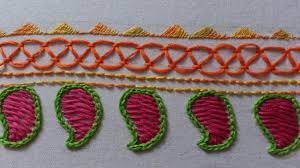
Lastly, top 5 tailors in Bangkok offer excellent services and products so that people are very satisfied with them. Universal tailors Bangkok create all exclusive style patterns and designs.
#Traveling Tailor in USA#top 5 tailors in bangkok#top tailors in bangkok#tailor near me#universal tailors Bangkok
0 notes
Text

I posted 3.804 times in 2021
2682 posts created (71%)
1122 posts reblogged (29%)
For every post I created, I reblogged 0.4 posts.
I added 5.793 tags in 2021
#age of sail - 2045 posts
#naval art - 1259 posts
#naval history - 854 posts
#naval artifacts - 391 posts
#19th century - 303 posts
#age of steam - 271 posts
#18th century - 220 posts
#tall ship - 180 posts
#ask - 144 posts
#early 19th century - 126 posts
Longest Tag: 140 characters
#the ceiling height can be explained by the fact that the victory is much older and was built differently than the later mid 19th century shi
My Top Posts in 2021
#5

Five whaler made scrimshaw rings, c. 1860
2595 notes • Posted 2021-06-21 10:20:39 GMT
#4
Sailors Needlework
Due to the fact that sailors had to mend their own clothes and there was always a sailmaker with his mates, many on board were very talented sewers. Therefore, many of them went beyond simple mending and created their own clothes. Or began to embellish their pieces with embroidery or make presents for their loved ones. Or earning some money on the side with their skills.
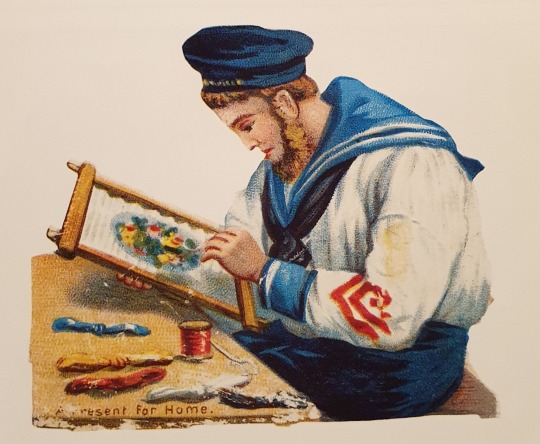
Sailor doing needlework, c. 1850 by unknown in: Jack Tar a Sailors Life, by J. Welles Henderson
It is not possible to pinpoint the exact origins, as many pieces have been lost over time.
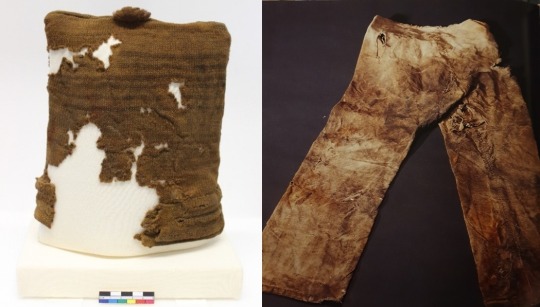
A knitted wool hat and handsewn pants, from HMS Invincible, 1758, in: The First HMS Invincible (1747-58): Her Excavations (1980-1991), by John M Bingeman
Some pieces date from the 18th century, while most seem to date from the 19th or 20th century. However, it can be assumed that there are also much older examples.
Embroideries
This type of decoration was embroidered with coloured silk or wool threads on the shirts or duffle bags. But also ribbons, bags or money belts were decorated.
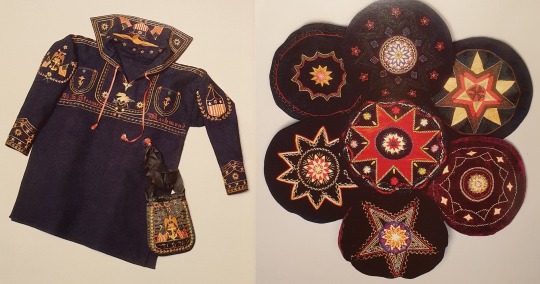
Sailor blouse and poke bag, made by George W.W. Dove, c. 1860 - Sailor’s Hats, c. 1850-1900 in: Jack Tar a Sailors Life, by J. Welles Henderson
Then names, mottos, stars, figures, ships, flags or anchors were embroidered on them.
Money belt, c. 1850 in: Jack Tar a Sailors Life, by J. Welles Henderson
Often the work was done in simple chain-stitch and the material was either taken from home or bought in a harbour.
Wollies
This type of embroidery is a very special form of embroidery, the embroidered woolen pictures, called woolies, which have been around since the 1840s. Most of the materials used to make woolies were found on board ships. Sailcloth, duck cloth from sailor's trousers or a simple linen or cotton fabric served as the backing. The runner was usually made from surplus wood with simple mortise and tenon joints, without wedges.
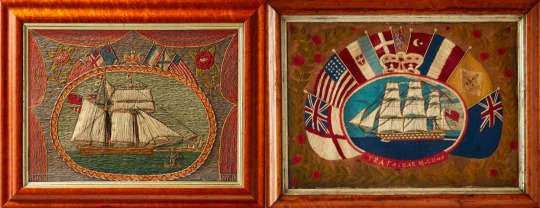
Theatrical curtains, often depicting trade union banners, suggest the artist was a merchant sailor. c. 1875 - HMS Trafalgar, c. 1865 (x)
Only the Berlin wool, cotton or silk had to be brought from home or purchased in a foreign port. The sailors mainly chose vivid colours - especially white, blue, red, brown and various shades of green. Early Woolies are made from naturally dyed wool. After the development of chemical dyes in the mid-1850s, sailors could obtain a wider range of colours at a cheaper price.
HMS Cumberland, c. 1842 - A third rate together with a paddle steamer, c. 1860-1880 (x)
When making a woolie, the sailor sometimes first sketched the outline of the ship and rigging in ink. With only these schematic designs, he then sewed these images freehand directly onto the canvas, using both rudimentary and refined stitches. Indeed, many Woolies show charming liberties taken with the appearance of elements other than the ship.
Multiple ships raise the value of a piece. This one showcases a second-rate ship, fourth-rate ship, frigate, and smaller ship, 1875 - HMS Queen a present from my son, c. 1855 (x) in: Jack Tar a Sailors Life,by J. Welles Henderson
The sailors used a wide variety of stitches, such as cross stitch, chain stitch, darning and the quilting technique called trapunto. Many of these pictures were appropriately made for the dearest ones at home. As the Victorians liked to collect, the pictures quickly became very popular and were often sold.
Knitting
The men on board also did this. Even though it's hard to imagine how old salts sat there and knitted. But for the cold days, the men needed warm clothes and so they knit socks, gloves and scarves.
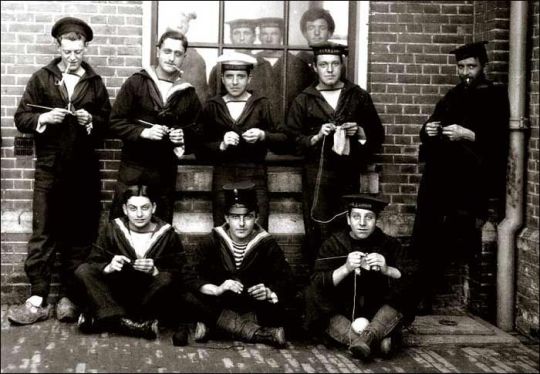
British sailors knitting or crocheting (and looking like they enjoy it!) during WWI (x)
(Those who have read the Hornblower novels by CS Forester will perhaps remember that in some books it is mentioned that the men sat there and knitted.) It is verifiable that the Sailors knitted from the 18th century onwards, but since this art had also been known since the 13th century, it must have come on board earlier.
3374 notes • Posted 2021-02-04 21:10:27 GMT
#3
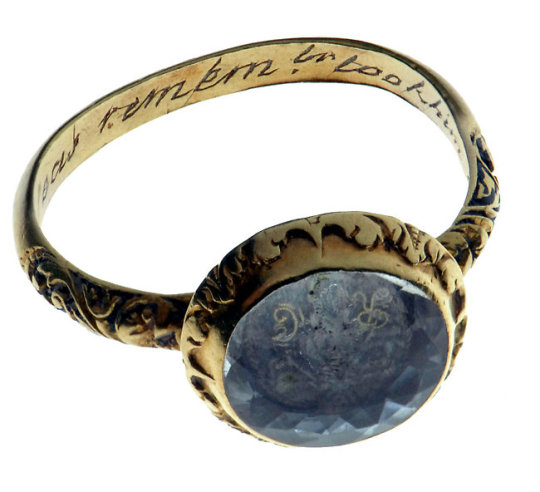
A woman’s “poesy ring” with initials, from 1592, made of gold and rock crystal.
On the ring’s inner surface is inscribed, “The cruel seas, remember,
took him in November.” From a love token to a memorial/ mourning ring, a fate that often befell many wives or mistresses of sailors.
6044 notes • Posted 2021-01-08 14:37:50 GMT
#2
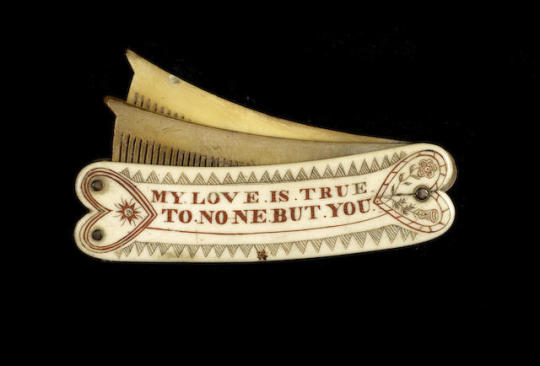
A scrimshawed and polychromed double comb, sailors love token, British, mid 19th century
6861 notes • Posted 2021-11-06 21:00:27 GMT
#1

Curious Polar bear (Ursus maritimus) standing upright and looking through porthole into the kitchen of arctic expedition ship M/S Stockholm in Svalbard, Spitsbergen, Norway by Andy Rouse
101387 notes • Posted 2021-01-27 15:06:56 GMT
Get your Tumblr 2021 Year in Review →
62 notes
·
View notes
Text
Mary Linwood
Credited as the most notable needlepainter of the eighteenth and nineteenth centuries, along with Mary Knowles and Anne Eliza Morritt, embroidery historians unfailingly list Linwood as the artist who inspired the practice of Berlin wool work, today known as needlepoint. Linwood's exhibitions were contemporaneous with the rising popularity of Berlin wool work, until the Royal School of Needlework and the Arts and Crafts movement began to criticize Berlin wool work for having led to a loss of embroidery skills, and in later decades Linwood's notoriety was put in question due to its association with Berlin wool work.[5]
0 notes
Quote
Top 10 Emerging Fashion Brands 2017
Despite 2017’s spate of ultra-hyped brands, the most exciting emerging names this year built awareness by fostering quality output, original design concepts and placing themselves among the right crowd. Rather than following predetermined formulas, these brands forged new paths, bringing original voices to the fashion echo chamber. In no particular ranked order, here are 10 of 2017's best emerging brands.
01
032c
01
032c
As a magazine, 032c leads the wave of progressive, modern fashion tomes, featuring industry icons like Raf Simons alongside newcomers like ALYX. Its accompanying collection of merchandise, designed by Maria Koch, was equally trailblazing; since kicking off in 2016, the apparel and accessories lines have become a hot commodity. It’s stocked by SSENSE, redesigned in collaboration with Stüssy and imitated by a wave of other media outlets, which have also started to issue their own in-house merch lines.
032c clothing is generally straightforward -- imagery, slogans and branding is repurposed across a range of graphic T-shirts and hoodies. Its simplicity is effective; Koch affirmed in an interview with SSENSE this year that when designing the brand’s graphic goods, "we just try to make them very attractive, hardcore and sexy." The outcome makes for immediately effective, highly collectible wearables not too far removed from the likes of Supreme and Richardson. 2018 will likely only see the brand’s influence spread.
02
SOME WARE
Some Ware
Cali Thornhill DeWitt launched Some Ware with Brendan Fowler in 2016 after working with Kanye West on The Life of Pablo merchandise. The pair’s collaborative line serves as a vehicle for their in-demand artwork, emblazoning bold graphics across ranges of organic cotton, USA-made T-shirts and accessories. Utilizing a unique cataloging system, the brand grants each product (including its events and Tumblr page) a specific number, signifying that each release is unique and also that each undertaking serves the brand’s greater purpose.
This year, Some Ware maintained a consistent flow of desirable gear, leading up to the label’s debut showing in Paris and a buzzy LA pop-up. The brand’s emphasis on community and DIY expression ensures that Some Ware will continue furthering its artistic vision for years to come, whether it breaks into the mainstream or not.
03
03
SSS WORLD CORP
SSS World Corp
Following his brief tenure at Brioni, Justin O’Shea launched SSS World Corp, a 032c-backed "luxury streetwear" label, which debuted its Spring/Summer 2018 line in late 2017. Meshing O’Shea’s taste for the ostentatious (leopard and tiger-print velvet coats) with the recognizable (trim wool suits), "Aloha from Hell" -- the brand’s debut collection -- is a blend of the street style icon’s preferred looks.
Although street-minded suiting is nothing new, O’Shea’s bombastic approach to blending slim tailoring with bold graphics is the next logical step for fans looking to blend Saint Laurent’s unpretentious cool with Off-White™’s visual appeal. With approval from fashion insider Etienne Russo, colette, Selfridges and other industry icons, SSS World Corp is poised for a bright future, with plans to offer more expansive future collections.
04
GMBH
04
GmbH
Multicultural fashion collective GmbH formed on the dance floors of Berlin, drawing upon the youthful energy for progressive takes on cool-kid club gear. The brand showed its second collection in Paris in early 2017, and immediately garnered notice from the fashion cognoscenti. Vetements comparisons came immediately -- after all, both labels hinge upon a low-key collective of European innovators subverting traditional fashion under an unassuming brand name (GmbH essentially translates to "Inc." or "LLC" in German). However, GmbH’s inspirations and intent differ, yielding distinct designs. Unconventional materials like PVC, vinyl, reflective polyester and upcycled puffer jackets formed the basis of the brand’s Fall 2017 collection, which received a bevy of positive critical attention and earned the brand stockists ranging from Opening Ceremony to SSENSE.
05
05
READYMADE
READYMADE
No longer Japan’s best kept secret, READYMADE is a certifiable success story. The young label’s exquisitely crafted garments first garnered buzz in 2016, before exploding into the spotlight this year. This year saw Yuta Hosokawa’s reworked gear on the backs of Travis Scott, Erykah Badu and Meek Mill, emblazoned with BAPE imagery and Just Don embroidery and reshaped into Fear of God’s short-sleeved overcoats. Each READYMADE garment boasts textiles sourced from vintage military clothing and goods, with authentic wear-and-tear still evident on each time-consumingly handmade piece. Hosokawa defines the label’s ethos as anti-war, because "deconstructing military wear during peacetime is a signal to end all wars. It’s a signal that we have no need for war in the modern era." Indeed, it’s a good thing that no one else is using the fabric, because READYMADE has plenty of forthcoming releases queued up.
06
Advisory Board Crystals
Advisory Board Crystals
With only one year under its belt, Advisory Board Crystals has amassed impressive stockists, including colette, Bergdorf Goodman and Union LA, with whom it released exclusive goods. At face value, the young label looks like the descendent of the '60s hippie and '90s New Age movements, with its vague name, colorful tie-dyed shirts and predilection for gemstones. Although one can see the label’s roots begin in decades long past, it has more in common with the #vaporwave music trend that exploded across cyberspace a few years back; the brand’s mindset repurposes those once-corny mindsets with a knowing wink, undercutting the edgy, overly-serious streetwear labels that emblazon knives and skulls on their cut & sew. The label’s meticulous hand-dyed, washed, cut, and sewn garments are sold alongside gems and crystals on the brand’s website, showcasing a slow-burn approach to clothing that flies in the face of fast fashion and trends, an attitude that continues to prove innovative going into 2018.
07
DOUBLET
07
Doublet
Designer Masayuki Ino has designed his line of playful casual wear since striking out on his own from Mihara Yasuhiro’s brand a few years back. With signature motifs like fringed embroidery and off-kilter graphic T-shirts, Doublet quickly amassed Japanese stockists, finding domestic success and developing its flavor of uniquely off-kilter clothing. However, 2017 was easily the label’s biggest year: Doublet debuted at Tokyo Fashion Week, collaborated with big names like 424 and Dover Street Market, and found a devoted fan in tastemakers like Travis Scott. International stockists range from Barney’s New York to China’s Lane Crawford, demonstrating the wide-ranging appeal of Ino’s oversized cuts and unique imagery.
Doublet Spring/Summer 2018 was its most progressive release yet, with pre-packaged dress shirts and dozens of off-kilter silhouettes.
08
08
No VACANCY INN
No Vacancy Inn
Boasting "the most authentic perspective I’ve seen in modern times," according to Off-White™’s Virgil Abloh, No Vacancy Inn is more than a mere clothing line. Headed by the culturally-aware Tremaine Emory and Acyde, the imprint serves as a barometer test of cool, merging music, art, fashion, and more into pop-ups and products. Although they dipped their toes into clothing in 2016, 2017 saw the pair delivered a complete collection with Abloh’s help; Off-White™ c/o Art Dad LLC debuted in January.
More concise drops continued throughout the year, including collaborations with VLONE, Denim Tears and Some Ware. Like the latter collective, No Vacancy Inn supplements its clothing drops with thoughtful podcasts and cultural examinations. No Vacancy Inn transcends the pigeonholing trap that many effervescent young labels find themselves in a year or two after breaking into the public eye. With supporters ranging from A$AP Rocky to Heron Preston, the brand has proven itself as a high-water mark of cultural exports.
09
Heliot Emil
Heliot Emil
Burgeoning Danish designers Julius and Victor Juul took their label’s name from their great-grandfather. Despite this nod to its heritage, the brand’s designs are distinctly forward-thinking. Juxtaposing contemporary trends with thematic inspiration, HELIOT EMIL is anything but Scandinavian minimalism. Still, the brand’s neutral color palette and ethical, Copenhagen manufacturing underline the brand’s blending of tradition and progression.
This year represented a major year for the imprint: A$AP Rocky showed support by donning several items from past releases, and the Spring/Summer 2018 show turned critic’s heads. Dubbed "Post-Traumatic Combat Stress," HELIOT EMIL’s adventurous collection turned military garments on their head with oversized cuts, hits of cool pastels and sardonic takes on militaristic hostility. Having taken its first baby steps into the consciousness of the fashion-aware, HELIOT EMIL has established itself as a promising contender amidst the ever-growing fashion landscape.
10
BILLY
10
BILLY
BILLY quietly earned the attention of celebrities like Justin Bieber and Kim Kardashian thanks to its luxurious, domestically-made loungewear. Drawstring-waisted pants, oversized melange sweaters and distressed tees assert its effortless styling, with occasional bold-lettered branding. As the fashion industry gears itself towards genderless clothing, Holly Jovenall’s unisex designs make for an accessible starting point, with an approachable blend of comfortable textiles and contemporary cuts; easygoing staples are granted a harder edge with leather rider jackets, sleek bombers and distressed sweaters, resulting in a comprehensive line that's both fashion-forward and wearable. This year saw the brand expand from a direct-to-consumer operation to being picked up by a bevy of high-profile stockists, which will hit shelves sometime next year.
Read more at HYPEBEAST
https://hypebeast.com/?post=4044145
0 notes
Photo
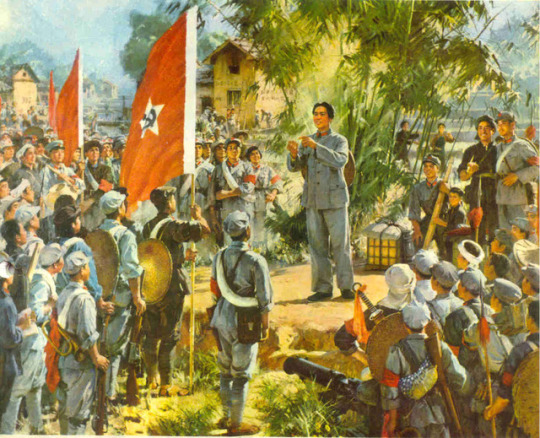
OF SOME FOREIGN PEASANTS
IN Russia the conference of gown could not function an index to the thoughts of the nation, for the peasant is allowed to share with the prince a elaborate for gold, colored embroidery, and silk and jewels, and it has not but develop into obligatory for the Duma to incorporate an advocate in the reason for costume.
The historical past of Russia is inscribed upon the gown of its folks. Travelling from north to south and from east to west, the costumes of the peasantry in every single place bear the impress of the political vicissi-tudes by way of which the actual locality has handed. This, coupled with the truth that no empire on this planet is made up of such an agglomeration of vastly completely different races, accounts for the immense range of types.
To realize some thought of the substances which go to make up the sartorial pot-pourri, one has however to pay a go to to the good annual honest at Nijni Novgorod. There Cossack rubs shoulders with Finn, Jew with Laplander, Tartar with Slav, Persian, Siberian, Bulgarian, and Circassian including to the curiosity of the scene and the Babel of tongues. As all the things Russian leads as much as the one forbidden, and subsequently burning, query, politics, it’s not possible even to 130 deal with of the nationwide costume with out touching flippantly upon these crises which decided the last word lower of a sleeve or the form of a head-dress.
Way back Byzantium imposed its faith and its fashions upon its nice northern neighbour. Each have been readily adopted by Russia, and a big side-light is thrown upon the nationwide character by the truth that when, within the thirteenth century, the Mongolian invasion reversed the political state of affairs, the vanquished adopted the gown of their conquerors, however not their religion. That is strictly true of all however the sovereigns, whose costume remained roughly devoted to custom, and by no means solely departed from the Byzantium authentic.
Though Byzantium dictated the fashions of the lessons, the plenty have been unaffected thereby, and the costumes of the serfs hint their supply to Slav and Tartar, in keeping with the district.
The primary issues to impress the foreigner
The primary issues to impress the foreigner are the attractive nature of the fete clothes worn by the ladies, and the lavish use of gold trimming. This love of gold, as utilized to ornamental functions, would seem inherent within the Russian character, revealing itself within the heavy gilding on the icons and the numerous glittering domes of Moscow and St. Petersburg. Extra suggestive of a fairy princess than of a peasant is the gala rest room of the feminine inhabitants of Tver. Contrived from thick silk shot with gold, the broad spherical skirt is pleated behind, the opening down the entrance and the hem bordered with gold, whereas the white chemisette vaunts puffed elbow-sleeves completed with frills, .three rows of pearls encircling the collarless neck. In summer season the little sarafan, or, for need of a greater time period, jacket, is made with out sleeves and resembles a brief full petticoat that stands out, as if stiffened, on the backside.
It, too, is of brightly colored silk, and descends from the armpits to beneath the hips, being supported by gold shoulder- straps, an edging of gold galon working spherical the underside and up the fronts. The top-dress consists of a species of gilt diadem set with synthetic gems in colored glass. This encircles the bottom of an erection of stiffened calico, reminiscent in form of the glass shades designed to guard these floral atrocities in Berlin-wool and wax that have been so expensive to the guts of the early Victorian housewife. Concealing the construction is a voluminous veil of white silk or gauze, striped or strewn with flowers, and invariably bordered with gold. The responsibility of gloves is carried out by casings of velvet and sable, which cowl the again of the hand and enclose the finger-tips, whereas leaving the palm and thumb free.
0 notes
Text
Hyperallergic: An Inclusive Documenta Succeeds Despite Curatorial Failures
Britta Marakatt-Labba, “Historja” (2003–07) embroidery, print, appliqué, and wool on linen, at the Documenta Halle in Kassel, (© Britta Marakatt-Labba/VG Bild-Kunst, photo by Roman März)
Documenta 14 opened in this week in Kassel, a dreary, small town in the center of Germany. The exhibition has been held here ever since it was founded, in 1955, as part of a larger project of reintroducing humanist images and traditions into postwar German society. Every five years, residents of this working-class town gear up to host about a million visitors from around the world, and pride themselves on being the “documenta stadt,” or documenta city, as its official tagline declares. This time, however, citizens were surprised to learn that the exhibition will open in another city before theirs: Athens.
Under this edition’s title “Learning from Athens,” the curators, led by artistic director Adam Szymczyk, have made Athens their home for the last few years, while they worked with local institutions and artists. They even declared at the Kassel press conference that they now felt like Athenians — a feeling other Athenians, based there for longer than just a curatorial project, reportedly did not share. The curators have set up the two cities as symbolic poles of today’s Europe: Kassel a working-class town in economically flourishing Germany, Athens the capital of struggling Greece; Kassel with barely any buildings constructed before WWII remaining, Athens crammed with layers of cultural history, the very image of Western civilization. Germany is Greece’s biggest creditor and engineered the austerity policies that had Greece debating whether to leave the EU in 2015; it has opened its borders to Syrian refugees, who have overwhelmingly landed on Greece’s shores. It is within this palpably strained relationship between the two countries that this year’s documenta is situated.
El Hadji Sy, “Disso—Concertation” (2016), installation of paintings with sound, installation view, at the Documenta Halle, Kassel, (photo by Nils Klinger)
The decision to open the exhibition in Athens is perhaps a gesture to include the Greeks in the cultural and material wealth of Germany. But it might as well just be an opportunity for the established exhibition to connect itself with the radical, anti-capitalist “bad boy” of Europe. The exhibition in Kassel is likewise propped up on grand curatorial gestures, to varying degrees of success. The traditional home base of the exhibition, the historical Fridericianum museum, displays the collection of Greece’s National Museum of Contemporary Art (EMST), while the EMST building in Athens, which has stood empty for years due to delays in construction and budget cuts, is documenta’s main venue there. In Kassel this remains a largely conceptual gesture: in losing the specificity of its locale, the Greek national collection makes little sense there.
A more successful curatorial gesture occurs at the Neue Galerie, which usually houses Kassel’s collection of 19th– and 20th-century art. Instead, it has been installed with a display dissecting the conditions under which art is moved, owned, shown, and perceived. The exhibition route here opens with “The Rose Valland Institute” (2017), a research project by Maria Eichhorn about art looted from Jewish owners by the Nazis, which
Maria Eichhorn, “Unlawfully acquired books from Jewish ownership” (2017) installation view, Neue Galerie, Kassel, Documenta 14, (© Maria Eichhorn/VG Bild-Kunst, Bonn 2017, photo by Mathias Völzke)
lends an air of uncertainty about the rightful ownership of artifacts to the whole exhibition thereafter. Images of classical Greece are scrutinized as a product of German imagination: from the writing on classical antiquity of Johann Joachim Winckelmann, a founding father of art history, to sketches of Greek sculptures by Arnold Bode, the founder of Documenta. Other rooms juxtapose racist images of othered bodies, such as 19th-century etchings of African slaves, Jews or Roma, alongside documentary information or works by artists of these heritages — probably another attempt at reflecting upon how these images emerge and circulate. But this academic strategy is disturbing, not because the images are shocking — after all, we are likely all aware of these ugly stereotypes, which still inform much of pop culture — but because this strategy awards these images visibility within a museum space. For an exhibition so concerned with the politics of visibility and the power of images to change consciousness, this display is especially hard to justify. It is a curatorial gesture, intrigued by historical coincidences, which forgot its greater purpose.
The most successful arc of the exhibition is not accomplished by any of its symbolic gestures but through the consistent and merited presence of non-white, gender non-conforming artists throughout. When successful, these works convey rarely seen perspectives of dominant narratives, claiming their validity in a preeminent contemporary art exhibition. Visual histories of colonization and indigenous pride are told: first by the imposing mural “Murriland!” (2017) by Gordon Hookey of the Waanyi aboriginal people, then by the delicately woven fabric piece “Historja” (2003-7), only 16 inches tall but 75 feet wide, created by Sami artist Britta Marakatt-Labba, and spread along a whole wall of the Documenta hall. Another strong piece is a video installation by Joar Nango: a collage of wasted landscapes made of materials pieced together in a journey across Europe. The video is a documentation of sorts of Nango’s travel from North to South, from snowy mountains to the sea, moving between industrial wasteland, rusty factories, raw materials, and the people and narratives that inhabit these marginal spaces. Other works that stand out are El Hadji Sy’s large object-paintings on raw canvas within wooden frames. They are arranged to form a circular barrier and may be seen from both inside the circle and outside, where their colors seep through and stitches that hold the painting’s base together become visible. And there is the homage to Lorenza Böttner, a transsexual artist from Kassel who had lost her arms at a young age and who had photographed herself in a variety of poses and personas that do not conform to mainstream images of gender or disability.
Lorenza Böttner, Drawings, pastels, paintings, video, and archival materials (1975–94) installation view, Neue Galerie, Kassel, Documenta 14 (photo by Mathias Völzke)
Paul B. Preciado, the curator of documenta’s public programs, declared that the exhibition gives agency to people whose essences were once reduced to their bodies, who had once been perceived as less than human — mere objects of display. As a transsexual, this is a personal project for Preciado, and one that is convincingly displayed throughout the exhibition. This is not a return to identity politics, as Chris Dercon, director of the Volksbühne, disparagingly announced at a talk I attended in Berlin shortly after the Athens opening. Instead, it is a statement of body politics, a physical occupation of the white spaces of high art, a flipping of agency and power — even a performance of the marginalized body’s own presence, until that presence takes root. In rare moments throughout the exhibition, this can be sensed — between the cracks of its grand curatorial gestures.
The Athenian portion of Documenta 14 is on view at locations throughout the city through July 16. The Kassel portion of Documenta 14 is also on view at various locations and runs through September 17.
The post An Inclusive Documenta Succeeds Despite Curatorial Failures appeared first on Hyperallergic.
from Hyperallergic http://ift.tt/2sMheDg
via IFTTT
0 notes